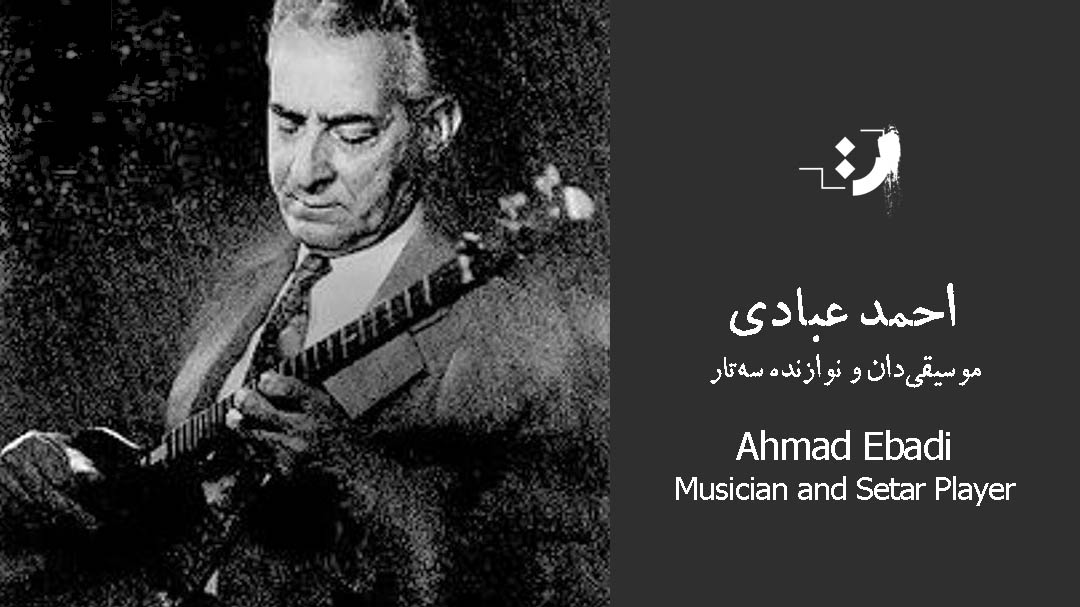Ahmad Ebadi

Biography
ʿEBĀDĪ, AḤMAD (b. Tehran, 1305/1906, d. 1371 Š./1993; Plate LVI), one of the outstanding modern masters of Persian music. He was a grandson of ʿAlī-Akbar Farāhānī (d. ca. 1275/1858) and a son of Mīrzā ʿAbd-Allāh (1261-1336/1845-1918), the great masters of their own times. ʿEbādī began accompanying his father on the żarb (see DRUMS) at the age of seven years, then took lessons on the setār from his two sisters Mawlūd Ḵānom and Molūk Ḵānom before studying briefly with his father (Ḵāleqī, pp. 128, 453-54) . In 1303 Š./1924, at the age of eighteen years, he appeared in his first public concert, accompanying the singer Molūk Żarrābī. Subsequently, however, he became an official in the Tehran municipal government and later in the Ministry of Culture (Wezārat-e farhang), deferring his public career until 1321 Š./1942 (Behrūzī, p. 116). For the next ten years he participated actively in the development of the musical radio series Golhā-ye jāvīdān, directed by Dāwūd Pīrnīā. It was through the radio that he attracted a growing audience for the setār. In 1337 Š./1958 he played in concert in Paris and thereafter in several European countries. He continued to perform regularly in Persia until 1358 Š./1979. He generally appeared as a soloist or accompanied by the żarb and frequented private circles of music lovers, where the special charm of his playing was appreciated.
ʿEbādī played a leading role in popularizing the setār; the appeal of his performance resulted partly from the development of a new style involving slight technical and acoustical modifications to the instrument, which he undertook upon his disappointment caused by hearing recordings of his own first radio performances. In contrast to the traditional style of playing, his own was much less rapid, with sharper contrasts in timbre and intensity and less systematic reliance on the drone on all the strings (During, 1984, pp. 45-46); it was characterized by a rich sonority resulting from a firm and broad attack, made easier by a slight displacement of the strings from the sounding board and the use of strings 10-20 percent thicker than usual. Another of his contributions was a very large number of different tunings (kūk), which allowed him to play the traditional musical modes (dastgāh) in unfamiliar tonalities that lent them original coloration (for a list of his tunings, see ʿEbādī, Šīvahā). On the other hand, ʿEbādī never shifted the frets of his instrument, which were at fixed intervals (analyzed by During, 1985, pp. 110-18; idem, 1991, pp. 49-52), regardless of the mode. Available recordings include performances of the dastgāhs Māhūr and Daštī (cf. Zonis) and Šīvahā-ye novīn-e kūk-e setār (cf. ʿEbādī).
ʿEbādī had no children and trained very few students, but his style inspired not only players of the setār but also most of the instrumentalists of the period 1329-59 Š./1950-80. Although he was extremely generous with advice, he played no role in transmission of the repertory (radīf), placing innnovative improvisation and development of a personal style above academic knowledge. For ʿEbādī the setār had to touch the heart, but, though its tone is naturally melancholy, it had also to be able to express joy; he believed that it should never be played in the open air or in an orchestra, where it could have only a secondary role (Behrūzī, p. 119). As for his audience, according to Mīrzā ʿAbd-Allah, “Two listeners are not enough; three are too many” (Behrūzī, p. 117).
For a music sample, see Ebādī Aḥmad.
Bibliography:
Š. Behrūzī, Čehrahā-ye mūsīqī-e Īrān I, Tehran, 1372 Š./1993, pp. 113-19.
J. During, La musique iranienne. Tradition et évolution, Paris, 1984.
Idem, “Théorie et pratiques des gammes iraniennes,” Revue de Musicologie 71/1-2, 1985, pp. 79-118.
Idem, Le répertoire-modèle de la musique persane. Radif de târ et de setârde Mirzâ ʿAbdollâh, Tehran (Sorūš), 1991.
A. ʿEbādī, Šīvahā-ye novīn-e kūk–e setār, 2 cassettes, Tehran (Sorūš), ca. 1369 Š./1990.
R. Ḵāleqī, Sargozašt-e mūsīqī-e Īrān, 2 vols. Tehran, 1333-35 Š./1955-56.
Ḥ. Naṣīrīfar, Mardān-e mūsīqī-e sonnatī o novīn-e Īrān, Tehran, 1369 Š./1990, pp. 226-29.
E. Zonis, comp., Classical Modes of Iran. The Dastgāh System, 2 vols., Folkways 8831-32.
Plate LVI. Aḥmad ʿEbādī plays the setār, Tehran. Photograph Faḵr-al-Dīn Faḵr-al-Dīnī, courtesy of M. Kasheff.
(Jean During)
Originally Published: December 15, 1996
Last Updated: December 2, 2011
This article is available in print.
Vol. VII, Fasc. 6, pp. 652-653
Cite this entry:
Jean During, “ʿEBĀDĪ, AḤMAD,” Encyclopaedia Iranica, VII, Fasc. 6, pp. 652-653, available online at http://www.iranicaonline.org/articles/ebadi-ahmad (accessed on 30 December 2012).
- Birthday: 1906
- Death: 1993
- Birthplace: Tehran, Tehran, Iran
Musician and Setar Player
